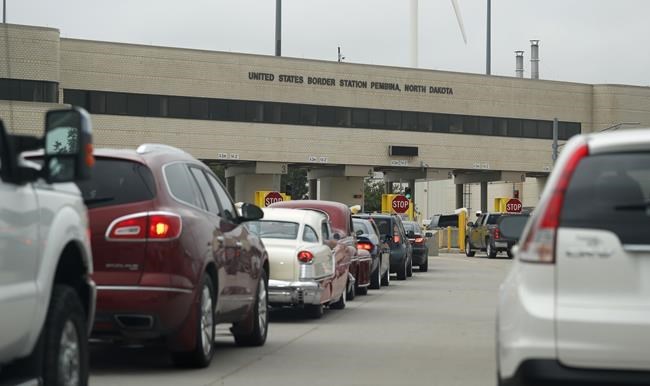
FILE - In this July 20, 2018 photo, traffic backs up at the border station as motorists leave Manitoba, Canada, for the United States at Pembina, N.D. The U.S. Customs and Border Protection won't restore hours of operation to pre-pandemic levels at some ports of entry in North Dakota, despite pressure from Gov. Doug Burgum. In a letter to the agency and the U.S. Department of Homeland Security sent Friday, Burgum said the reduced hours at several North Dakota port crossings along the U.S.-Canadian border "causes significant hardship on the movement of citizens, goods and tourists between our two nations."(AP Photo/David Zalubowski File)
Republished July 11, 2022 - 10:42 AM
Original Publication Date July 11, 2022 - 9:51 AM
BISMARCK, N.D. (AP) — The U.S. Customs and Border Protection won’t restore hours of operation to pre-pandemic levels at some ports of entry in North Dakota, despite pressure from Gov. Doug Burgum.
In a letter to the agency and the U.S. Department of Homeland Security sent Friday, Burgum said the reduced hours at several North Dakota port crossings along the U.S.-Canadian border “causes significant hardship on the movement of citizens, goods and tourists between our two nations.”
In a statement to The Associated Press Friday, the federal agencies said longer opening hours cannot be justified because of the shrinking volume of traffic at the border crossings — a decline that began even before the pandemic.
“For several years, pre-COVID, CBP documented a reduction in vehicles and pedestrian traffic along our northern border, and CBP’s obligation is to utilize all available resources responsibly to perform our mission of safeguarding the homeland,” the statement said.
North Dakota has 17 border crossings and the one at Pembina on Interstate 29 in the northeastern part of the state is the busiest. In April 2020, hours of operation were reduced by several hours in the evening at 10 of crossings. Hours also were shortened at some ports of entry in Montana, Minnesota, Idaho and Washington, and will remain that way, agencies said.
The federal government said at the time that the reduction in hours would be temporary.
On April 1, 2022, the federal government rescinded the requirement for fully vaccinated travelers into the U.S. to be tested for the coronavirus.
Burgum said in his letter that the relaxed rule spurred a 40% increase in the number of people entering the U.S. through North Dakota. But Burgum said the number of people crossing the border is still half of pre-pandemic levels.
“North Dakotans and Canadians in these areas are forced to cope with hours that do not accommodate the average person’s daily routine, Burgum wrote. “A North Dakotan’s day does not begin at 9 a.m. nor end at 5 p.m. Such limitations are unacceptable and cause significant hardship for people who wish to cross the border beyond these limited hours.”
The Republican governor estimated North Dakota lost more than $283 million in Canadian visitor spending due to the pandemic.
“Spending by these Canadian visitors constitutes nearly 10% of North Dakota’s annual visitor spending, and the importance of these international dollars to our economy cannot be overstated,” Burgum wrote.
Burgum sent a similar letter to the agencies earlier in the year, and he spoke with CBP Commissioner Chris Magnus in June to request extra hours. Magnus, who reports to Homeland Security Secretary Alejandro Mayorkas, is a former Fargo police chief.
In the tiny town of Noonan, just 7 miles from the U.S.-Canadian border, Donna Fagerland said there is a noticeable drop in the number of Canadians who visit her town of about 180 people.
“We used to be strangers in our own hometown,” said Fagerland, a 76-year-old former café owner in Noonan. “We’ve always had Canadians here, but not as many are coming down.”
The shorter hours at the port of entry, which opens at 9 a.m. but now closes at 5 p.m. instead of 10 p.m., has created a hassle for people on both sides of the border, Fagerland said.
Most visitors come from Estevan, Saskatchewan, a city of about 14,000 people about 20 miles from Noonan, she said.
Many come to North Dakota to hunt and fish but Noonan’s biggest draw is its two bars and post office, Fagerland said. Several Canadians own homes in town and many have their mail and packages shipped to Noonan because the postal rates are less expensive in the U.S., she said.
“They like to come down and pick up their mail and visit,” she said. “The drinks are cheaper, too.”
News from © The Associated Press, 2022